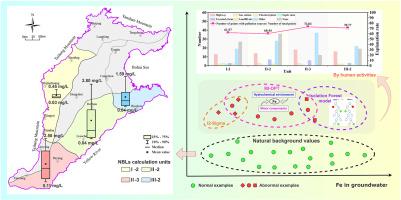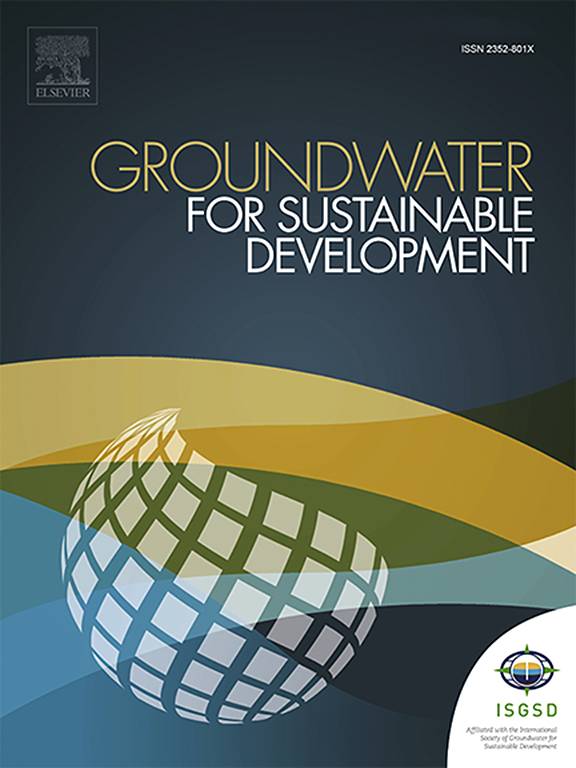华北平原代表性水文地质单元浅层地下水铁异常识别与NBLs估算的水化学与机器学习方法对比研究
IF 4.9
Q2 ENGINEERING, ENVIRONMENTAL
引用次数: 0
摘要
地下水中的铁(Fe)既有自然沉降的结果,也有人类活动的结果,影响着生物地球化学循环和各组分的迁移。人类活动的增加破坏了铁的浓度,导致偏离自然状态。因此,确定铁异常和确定其自然背景水平(NBLs)至关重要。在细分NBLs单元的基础上,选择4个典型单元进行异常识别,分别采用迭代2-Sigma法、改进水化学法(MI-OPT)和隔离森林模型。结果表明,MI-OPT方法性能稳定,并能识别与水化学指标相关的异常。隔离森林模型通过基于机器学习的分区方法有效地检测铁异常。相比之下,迭代2-Sigma方法由于依赖于数据分布而表现出不稳定性。根据剩余数据的分布特征,选择MI-OPT方法异常识别结果作为确定4个单元铁NBLs的最终参考,上限分别为0.45 mg/L、2.80 mg/L、2.58 mg/L和1.59 mg/L,由补给区逐步向径流区和排放区过渡。此外,结合信息熵、PPI值和环境污染源数据的综合分析解释了大多数检测到的异常,验证了异常识别结果的可靠性。本文提出的方法和结果为地下水铁异常识别提供了一个新的视角。本文章由计算机程序翻译,如有差异,请以英文原文为准。

Comparative study of hydrochemical and machine learning methods for Fe anomaly identification and NBLs estimation in shallow groundwater of representative hydrogeological units in the North China plain
Iron (Fe) in groundwater results from both natural sedimentation and human activities, impacting biogeochemical cycles and the migration of various components. Increased human activities have disrupted Fe concentrations, causing deviations from the natural state. Thus, identifying Fe anomalies and determining its natural background levels (NBLs) are crucial. In this study, based on subdivided NBLs units, four typical units were selected for anomaly identification using Iterative 2-Sigma method, modified hydrochemical method (MI-OPT), and Isolation Forest model. The results showed that the MI-OPT method showed stable performance and also identified anomalies related to hydrochemical indicators. The Isolation Forest model efficiently detected Fe anomalies through a machine learning-based partitioning approach. In contrast, the Iterative 2-Sigma method exhibited instability due to its dependence on data distribution. Based on the distribution characteristics of the remaining data, the anomaly identification results from the MI-OPT method were selected as the final reference for determining the NBLs of Fe in the four units, with the upper limits being 0.45 mg/L, 2.80 mg/L, 2.58 mg/L, and 1.59 mg/L, progressively transitioning from the recharge area to the runoff and discharge areas. Additionally, an integrated analysis incorporating information entropy, PPI values, and environmental pollution source data explained most of the detected anomalies, validating the reliability of the anomaly identification results. The methods and results presented in this study offer a new perspective on Fe anomaly identification in groundwater.
求助全文
通过发布文献求助,成功后即可免费获取论文全文。
去求助
来源期刊

Groundwater for Sustainable Development
Social Sciences-Geography, Planning and Development
CiteScore
11.50
自引率
10.20%
发文量
152
期刊介绍:
Groundwater for Sustainable Development is directed to different stakeholders and professionals, including government and non-governmental organizations, international funding agencies, universities, public water institutions, public health and other public/private sector professionals, and other relevant institutions. It is aimed at professionals, academics and students in the fields of disciplines such as: groundwater and its connection to surface hydrology and environment, soil sciences, engineering, ecology, microbiology, atmospheric sciences, analytical chemistry, hydro-engineering, water technology, environmental ethics, economics, public health, policy, as well as social sciences, legal disciplines, or any other area connected with water issues. The objectives of this journal are to facilitate: • The improvement of effective and sustainable management of water resources across the globe. • The improvement of human access to groundwater resources in adequate quantity and good quality. • The meeting of the increasing demand for drinking and irrigation water needed for food security to contribute to a social and economically sound human development. • The creation of a global inter- and multidisciplinary platform and forum to improve our understanding of groundwater resources and to advocate their effective and sustainable management and protection against contamination. • Interdisciplinary information exchange and to stimulate scientific research in the fields of groundwater related sciences and social and health sciences required to achieve the United Nations Millennium Development Goals for sustainable development.
 求助内容:
求助内容: 应助结果提醒方式:
应助结果提醒方式:


